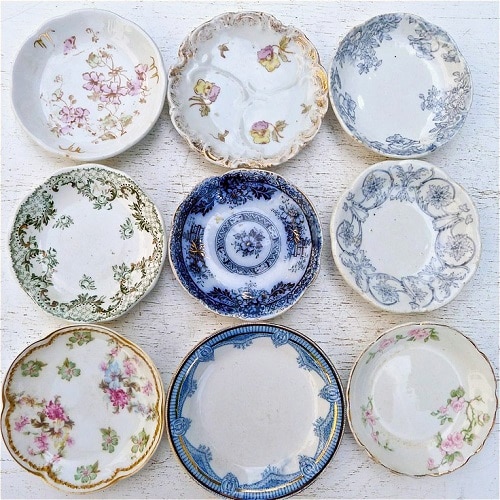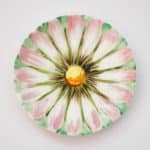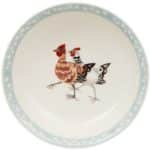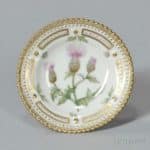By Jessica Kosinski
Pat-A-Pat
We all have traditional foods that we like to eat. Often, favorite foods vary by era and culture. However, one food that has stood the test of time is butter. Butter is so popular, in fact, that specific practices have been established and altered over the years for producing it, cutting it, and even serving it. For example, in the Victorian era it was particularly popular to use individual butter pat plates for each person at dinner. Those tiny dishes are also known as butter pats, butter chips, or butters. Let’s take a quick peek at the history of butter pats and how to collect them.
Making and Serving Butter
It is difficult to look at the history of butter pat plates without first delving into the history of making and serving butter a bit. As we all know, butter is very sensitive to temperature changes. If it gets too warm, it will melt. If it gets too cold, it will be too hard to cut. What you may not know is that butter used to be produced in large blocks. In the 1800s processes developed which allowed butter to be sliced into small “pats” (individual servings). Those changes corresponded perfectly with the Victorian era, which was a time when formal dinners and elaborate place settings were common. That led to the creation of butter pat plates.
In the United States and many parts of Europe butter pat plates were primarily used in the 1800s and into the early 1900s in the homes of affluent citizens who had elaborate dinnerware sets for formal dining. Each dinner guest was given his or her own butter pat plate on which to put a pat (or lump) of butter. The butter itself was often molded or stamped to form patterns, such as flowers, on the butter’s surface. Each individual lump of butter was then placed on a butter pat plate belonging to a specific guest.
Butter pat plates produced in the 1800s and early 1900s were primarily made out of either porcelain or sterling silver, and some made of glass. They were produced as part of dinner service sets or to match existing dinner service sets. Each tiny plate was typically less than three inches square and held either one or two pats of butter at a time.
The Changing Patterns of Butter Pat Plates
Some butter pat plates were simple square plates a bit larger than a lump of butter. However, Victorian families preferred elaborate patterns and designs. That led to the development of shapes and patterns which included shell or fan-like plates, as well as round plates.
The colors and designs on the butter pat plates also got more elaborate as time went on. Floral designs were quite common. In some cases the butter pats themselves were shaped and colored to resemble flowers. In other cases the butter pats were square or round and featured pictures of flowers in their centers or floral patterns around their edges. Other popular butter pat themes included animals and birds.
Butter pat patterns also changed as advertising methods evolved. Some later butter pats had pictures and slogans on them, which were used to advertise businesses, events, or advancements of some kind. Many of those butter pats are extremely popular today, especially those depicting transportation-related advertisements or themes.
Popular Butter Pat Plate Producers
As you might expect, many of the most popular butter pat producers are the “big name” porcelain producers which were historically popular for their dinnerware and decorative pieces. Among the most common and popular types of butter pats are Haviland, Majolica, and Waverly. Of Haviland’s up to 60,000 different patterns, most included butter pats as part of a place setting. However, there were many companies which each produced anywhere from just a few up to dozens of patterns made from many different materials.
Unusual Types of Butter Pats
Although many butter pats were mass-produced as parts of large dinnerware services, some are far more unusual. For example, several French and German butter pat manufacturers produced butter pats in the 1800s that were hand-painted later with elaborate designs and patterns. Some of them even featured hand-painted portraits of people.
Some butter pats, particularly in China, were also made for salesmen to use as samples of patterns, not for actual use. They were small and portable to show potential customers what larger dinner services would look like. Those sales models are fairly rare now, which makes them popular with collectors.
Today butter pats for practical use have gone out of style. They are rarely used for their intended purpose except in period homes where homeowners or historians want to maintain historical accuracy in their place settings. However, there are still some excellent reasons to collect butter pats. For example, many of them are inexpensive and often cost less than $10 each.
They can also be quite decorative while taking up very little space. That makes them perfect for collectors on a budget or with limited space who simply enjoy the fun of hunting and collecting. Butter pats can be found everywhere from yard sales and flea markets to online marketplaces, making shopping for them convenient as well.
Difficulties Associated with Collecting Butter Pats
There are a few difficulties associated with collecting butter pats. The main problem is that they are often difficult to recognize for what they are. In fact, they are frequently mistaken for doll furniture or children’s toys. It can also be difficult to date some butter pats or determine where they were manufactured, since they are not all individually marked. Some of them have been reproduced over the years as well, making it difficult to differentiate original pieces from newer reproductions.
Tips for Collecting Butter Pats
If you want to collect butter pats, then the beauty of the butter pat hunt is that you have thousands of options. You can collect butter pats made from a specific material, featuring a pattern or motif that you like, or made by a particular manufacturer. You can also choose to focus on butter pats produced in a certain country or during a certain time period. It all depends on your individual taste.
The important thing, if you plan to start a butter pat collection, is to learn to recognize butter pats when you see them. Since many people have no idea what butter pats look like, they often discard them or sell them for very little money at flea markets or in other similar settings. Therefore, if you want to buy inexpensive butter pats then you should focus your search in those venues. If, on the other hand, you want to collect rarer butter pats, you should check online auctions and specialty websites for the best results.
Jessica Kosinski has been a freelance writer specializing in writing short articles for 15 years. She is also an avid collector of both antique books and Star Wars memorabilia. Although she is not in the antiques industry professionally, she has learned a lot about antiques over the years by periodically helping out at her mom’s antiques shop in Greenville, NH. She currently balances maintaining the antiques shop’s Facebook page, www.facebook.com/MallofNE, and working on various freelance writing assignments. She can be reached at dementorskiss77@yahoo.com.











Related posts: